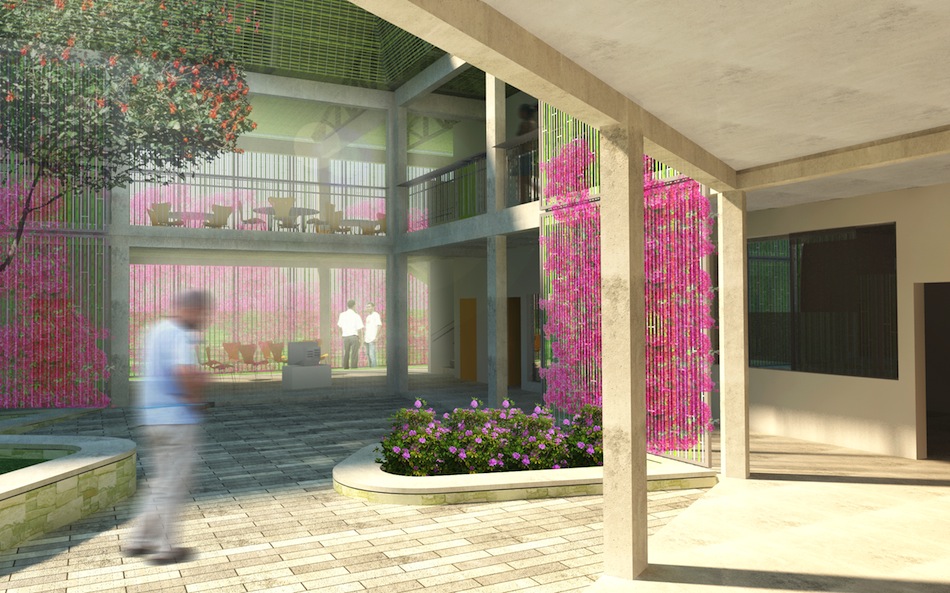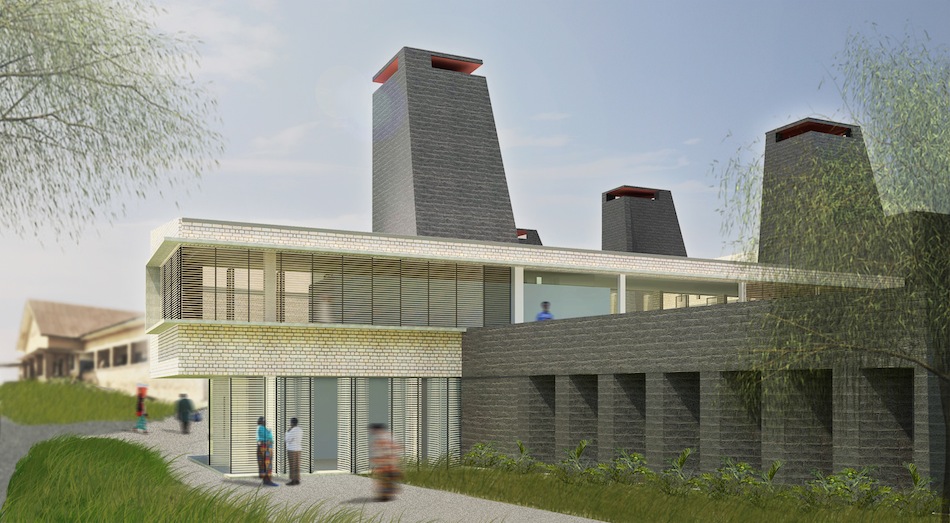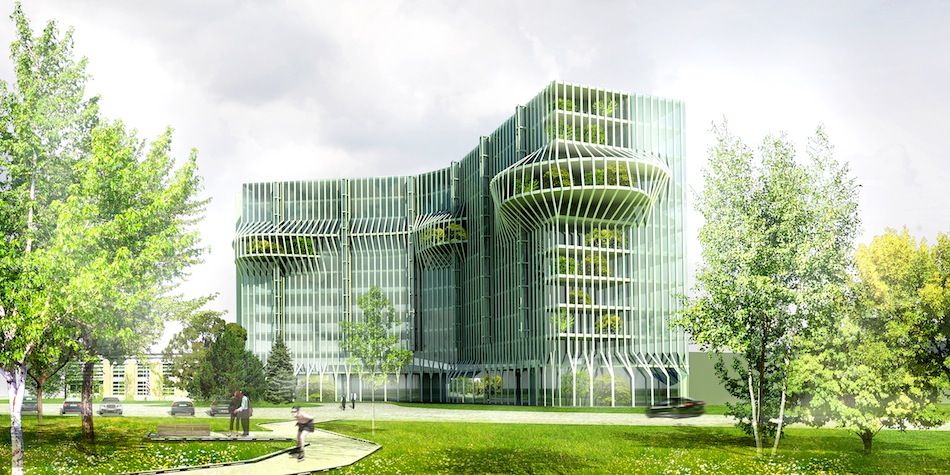Interview: MASS Design Group
EMERGING VOICE 2013
MASS Design Group
Sierra Bainbridge, Michael Murphy, Alan Ricks, and David Saladik of MASS Design Group argue that “Design is never neutral. It either helps or it hurts.” Casting its efforts across global socio-economic spectra, the office investigates the social determinants of poverty and illness and through design proposes holistic and inclusive solutions, as in the projects for the Butaro Hospital in Butaro, Rwanda; the Health Infrastructure Policy for the Liberia Ministry of Health and Social Welfare drafted in collaboration with the Clinton Health Access Initiative; and the Cholera Treatment Center in Port-au-Prince, Haiti. MASS Design Group maintains offices in Boston and Kigali, Rwanda. On the occasion of his Emerging Voices lecture with MASS co-founder Alan Ricks (video below), Michael Murphy sat down with League Program Associate Ian Veidenheimer to discuss his practice.
Ian Veidenheimer: As this is the Emerging Voices series, we emphasize the voice. How would you describe your firm’s voice?
Michael Murphy: Our firm’s voice is best described through the principles we live by. We believe that architectural design is never neutral: it either helps or it hurts. We are, of course, committed to working towards the former, requiring that every design decision has to help. But that’s a simple way to put it. The statement also suggests that design is never neutral, indicating that doing just the bare minimum, just the basics, actually can cause great harm. That approach can be very problematic in its negligence by not considering the full range of impacts that a better built environment could have. So I guess you can say we are against neutrality.
IV: Your work is often called social or humanitarian architecture, though you criticize the use of those labels. Why do you reject this idea of a social or humanitarian architecture?
We believe that architectural design is never neutral: it either helps or it hurts.
MM: I don’t believe there is an un-humanitarian architecture or an unsocial architecture. I don’t know what it would be. But those kinds of labels force us to ask, why must we bifurcate the discipline into a social architecture and a “capital A” architecture, as it has been divided? I don’t reject that the social implications of the built environment are important; on the contrary, I believe we have to emphasize the fact that they are always relevant. And if they’re always relevant then we always have to be working towards design decisions that somehow improve our lives in a better, healthier, non-neutral way. It’s about building a new value system for architecture.
IV: In line with this pursuit of social value, your projects are sites of production in every sense of that word. How do you inspire that level of civic engagement?
MM: One of our theories of change is that if architecture is to effect social change there has to be a societal expectation that it can. Right now the public’s expectation of what architecture can and should do has bottomed out. We need to shift that perception. It’s not enough to just build something; it must produce different notions of what a successful building is.
We are very interested in different ways in which the buildings’ users can be engaged, and have to be engaged, in order for architecture to be successful. An immersive, deeply involved, on-site research process is important. It’s not simply about gathering information; it’s about building a coalition and through that engagement process creating a shared vision. The least that process can do is get everybody on board for a project; the best it can do is get people to share a vision they didn’t know they had and thus together build something greater. We hear a lot about “air lifted-in building” even in the U.S. We attribute that largely to formal decisions, but I think it’s also about failed engagement. Collaboration, education, walking people through the process of building together is what builds a community around a new piece of infrastructure—and that is what’s missing from our strategies of construction now. This engaged process can be helpful in the Congo, and it can be helpful in the U.S.
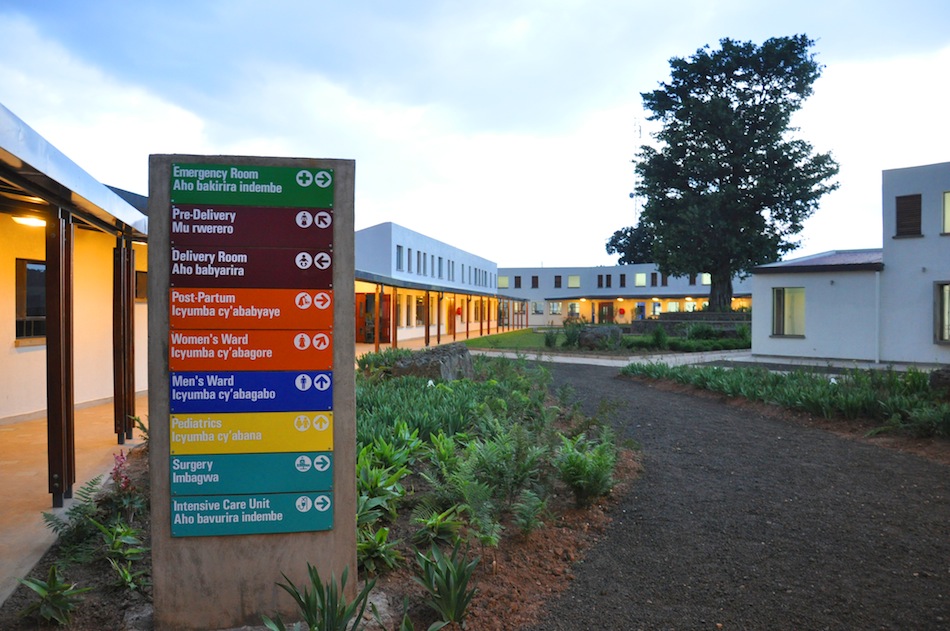
Rwanda Ministry of Health, Partners In Health (PIH), Butaro (Rwanda), credit: MASS Design Group
We have a few built buildings, the Butaro Hospital being a good example, where we’ve seen real commitment from the community to maintain it—literally maintain it in their volunteer time. People from all over the region commit time to keep up the grounds. That tells us that there is real ownership. That tells us that the design has brought something more than just a building. It has produced a sense of dignity. That’s fundamental to developing not only a local economy, but developing a worldview that design can produce—and that we deserve—something more than just the basics. A worldview that architecture can create dignity, produce human value, and reduce suffering.
IV: Much of that value creation seems to depend on a very intimate relationship between the building and labor, and on the community participating at both ends of the process. How does that model translate to places like New York City where we don’t really know how to value labor, we’re not particularly involved in the making of our built environment, and we don’t understand where the materials come from? In this context, how can we value the services that you provide?
MM: I think that’s an economic question. Labor in the U.S. is more expensive and materials are cheaper. It’s an inverse relationship, for example, in Rwanda, where materials are expensive and labor is cheap. Each just requires a slightly different strategy for how to produce infrastructure or architecture and how you design the process. Labor costs are not irrelevant, but I think we have to rethink what has been not only a trend but a valued goal and strategy of making the building process more efficient through, say, prefabrication. Prefabrication can be a strategy to lessen the cost of the production of a building, but it’s also a way to industrialize the process—a strategy that, in some cases, is actually less efficient because it removes the human variable. We learned this in Haiti, where everyone was proposing prefabrication processes, which makes no sense. Why would you introduce an industrialized process, which is based around the economy of labor in the U.S., and export that to an economy where the first thing needed is jobs? We’re exporting an innovation in the process of building, and forgetting that that innovation is dependent upon the variable of labor.
Few professions have a fiduciary responsibility to the public. Architecture does.
That strategy is also still relevant here in the U.S. We need jobs. We need craft. And we need materials that are locally sourced. I was talking to a union organizer in Austin, Texas; he said construction work used to be a solid blue-collar job. You could support a family on it and live your life while producing your craft. Now it’s an inexpensive imported industry that is primarily being reduced to low-skill labor. Those craftsmen, with skill sets and expertise, have been pushed out of the marketplace. This is a reality in the U.S. economy that’s been determined by a lot of variables, including economic policies, regulations, and global flows of materials. But architectural decisions are also one of those variables. We can choose to hire laborers from the community and use material from the local area. That’s just a choice. And I think it’s something we can insist upon to bring vitality back to these markets.
IV: So do your buildings reflect these values based on labor, resources, and the services your buildings provide? Do you want that readability?
MM: Absolutely. In fact, when we talk about what we find attractive in architecture, it is the legibility of the hands that make it. Will Bruder is an architect who I admire and who taught me that too. His Phoenix Central Library, which is a phenomenal project, has cast panels in the back. He let the laborers make each panel the way they wanted to, so none of them are the same. It creates this beautiful tectonic response, and a formal and aesthetic beauty that generates a human-crafted legibility. To us, that is beauty. In fact, that is what our architectural hero, William Morris, would say: Beauty is the production of labor. It’s not the production of form. Beauty is created through labor.
IV: So in calling for this greater appreciation for and awareness of the merits of architectural services and processes, you seem to identify new markets and opportunities for design, which is a powerful role to take. Do you see your role as an architect as a powerful position in the communities where you work?
MM: Architects are always aligned with power and really always have been, from cathedrals to skyscrapers to banks. Infrastructure is expensive. Buildings are costly; always have been, always will be. The architect is the partner to those with the capital to invest. And so the architect is in a privileged position to help shape the way that power is distributed, and that is one of the great responsibilities of architecture. It is why architects in practice, in their legal obligation, have a fiduciary responsibility to the public. Few professions have a fiduciary responsibility to the public. Architecture does.
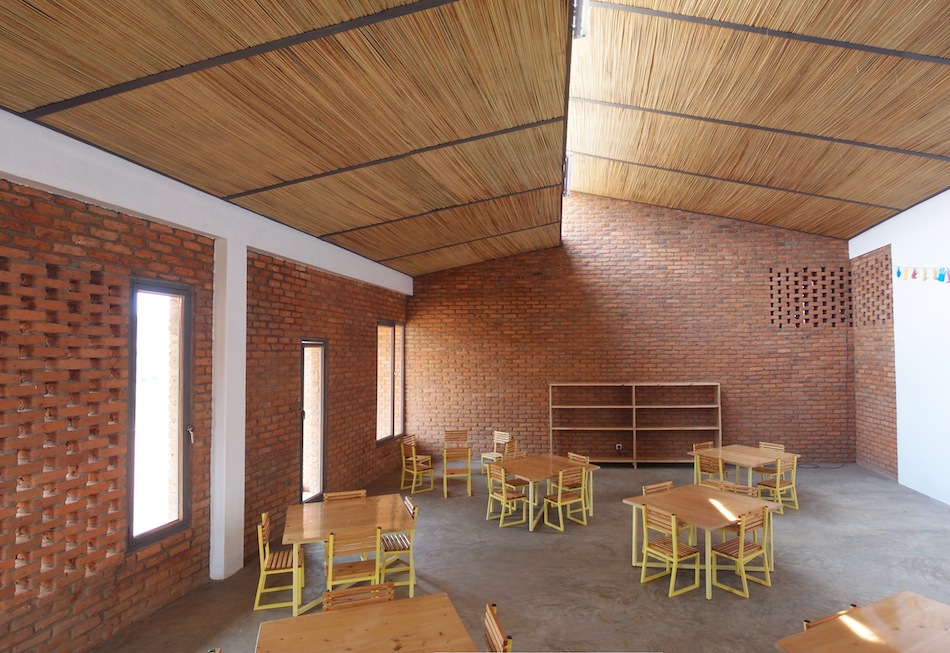
Girubuntu School, Kigali (Rwanda), credit: MASS Design Group | click for a project slideshow.
That connection with power also puts architects in a unique position to be able to guide decisions—and have a responsibility to guide decisions—that serve the public. I think where some participatory architecture processes break down and aren’t able to effect change is when the architects shy away from the uncomfortable relationship of being aligned with power. Design by committee is not design at its most useful. Design is incredibly useful when the architect acts as a convener and can develop and gain knowledge, ask questions, and ultimately solve problems. The architect has an important, powerful role there and must embrace it. If we only work for those in power, waiting for a client to call, instead of working with the systems of power up front and then seeing projects emerge out of our own dialogue, we’re missing an opportunity. We have to be out in front making decisions about infrastructure, human settlement, or healthcare. If we take that stand, new markets emerge and new opportunities unfold in front of us that we didn’t think existed before. Being comfortable with these dynamics creates opportunities for all architects, creates more jobs, and assists the public good.
IV: How should someone who is not an architect participate in that shift in societal expectation of the role or power of the designer?
MM: I think the public needs to ask, and is starting to ask, what is the role of architecture? What is the role of design in improving our lives? The public should demand more and expect more of our built environment. We need advocates in every discipline to rethink some of the entrenched systems, be they legacy or just habit, that are defining our world.
Take healthcare as an example. The role of design in improving a doctor’s ability to serve patients isn’t necessarily easily understood. But we are starting to see healthcare providers and people in public health asking questions like, what are cities’ effects on public health? What does it mean if you drive everywhere? What does it mean to our public health? What does that mean to our rate of diabetes and obesity in this country, which is now our greatest epidemic? Those issues are the result of design decisions or a lack of design decisions.
I think successful architects are those who produce knowledge, not commodity.
The relationship between public health and our built environment of course is not new, but it is a forgotten knowledge that is starting to reemerge. We learned this in studying cholera. Cholera is a disease of the failed built environment, it’s a disease of a failed sanitary system. John Snow discovered the root cause of cholera in 1850 through a mapping exercise that helped him trace a cholera outbreak to a broken sewage line that was spilling into a water well. What changed from the John Snow map of cholera were three important disciplines: epidemiology and healthcare, public health, and modern urban planning. All three for a moment shared the same goal, which was to improve the public’s health and to improve rapidly urbanizing areas that were facing problems of poverty and insufficient infrastructural systems. Now these fields are very far apart, but we are trying to pull them back together. These disciplines can benefit from asking questions outside of themselves to see how they are interrelated. So going back to your question, someone who’s not an architect can be an advocate within their discipline, can help other disciplines in this transfer of knowledge, and to generate this conversation so that it’s much broader, which it needs to be.
IV: There’s a really wonderful optimism to what you do. You began your presentation yesterday with the argument that architecture, or specifically the act of building, and place making can create real and felt peace; it can resolve conflict. Can you talk more about that?
MM: This is a really new idea for us, and I think it reminds me of why the reformed building process is not just icing on the cake. It’s not just beneficial, it’s imperative; it’s imperative because the potential to impact local communities is all in that process of building. So when architects only think about the object or the end result, they fail to define how the building process can come about, and if they fail to define that process, as we’ve seen in Rwanda, things that can be disruptive to the point of discord. And the inverse is true as well, or at least that would be the proposition.
IV: How do you balance your roles as both the practitioner of architecture and an advocate for this vision of the future of the profession?
MM: Architecture works best when it is aligned with a vision, and vision needs to be developed in the public domain. The public needs to participate in helping guide and shape strategies for improving our built environment and imagining what architecture could be. That’s one of the reasons why we are so interested in reaching beyond the architectural bubble, to healthcare, to the social innovation sector, to business, global aid, infrastructure, and politics.
We need to expand beyond the borders of only the academy, or only an efficient practice, although both are important. It has to be everything at once. Many architects believe this, and many recognize the value of teaching and giving back. Architects have a responsibility to train the next generation of those who will guide the built environment. It’s a commitment to advocating for something bigger, to extending knowledge that you’ve gained beyond your practice into the public domain.
I think successful architects are those who produce knowledge, not commodity. If we are only interested in producing commodity, we lose the potential to produce knowledge. If our firm is known for the construction and distribution of knowledge, that would be something to be really proud of.
•••
Michael Murphy and Alan Ricks, Mass Design Group, Emerging Voices 2013, complete lecture video | Recorded March 14, 2013 | Running time: 39:04
•••
Michael Murphy is a founding partner and executive director of MASS. He received a M.Arch from Harvard University and currently teaches at the School of Visual Arts Design for Social Innovation. Alan Ricks is a founding partner and chief operating officer of the office, receiving a M.Arch from Harvard University. Sierra Bainbridge is a senior director at MASS. She received her M.L.A. and M.Arch from the University of Pennsylvania. David Saladik serves as a director at MASS and received his M.Arch from Harvard. MASS’s work appears in a wide range of publications and most recently received the 2012 Curry Stone Design Prize.



